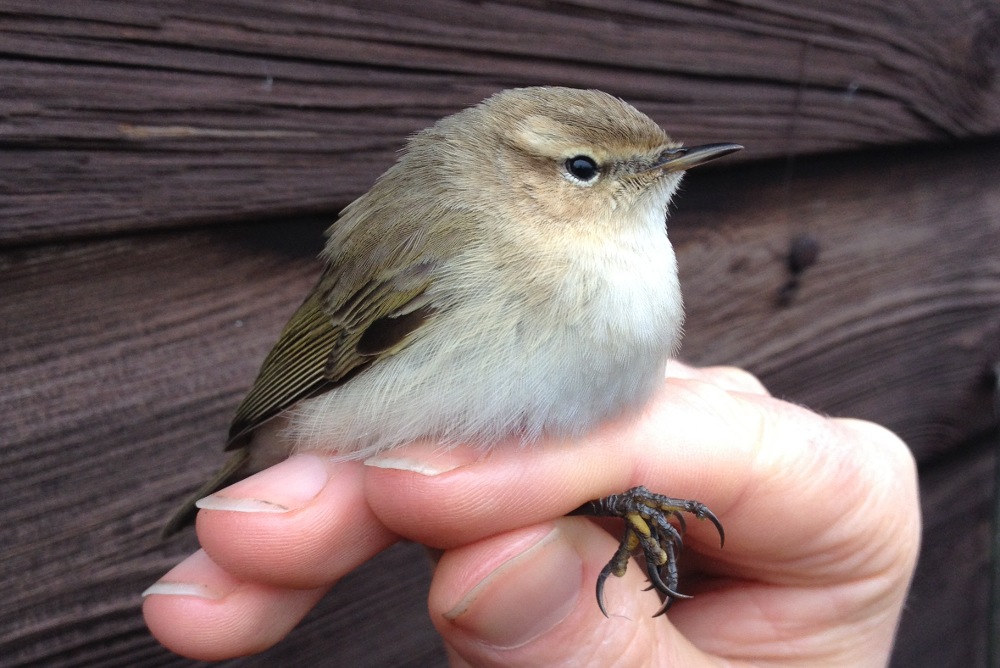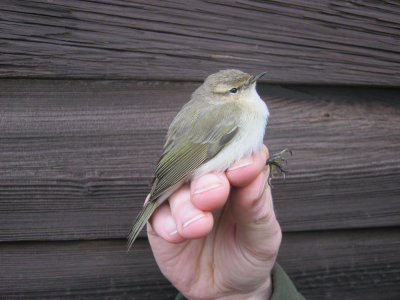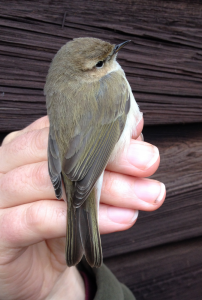
British Chiffchaff ('collybita' race) in Autumn after post-juvenile moult (Roger Emmens)
A review of our wintering Chiffchaffs
Rye Meads is one of the best places in Hertfordshire for wintering Chiffchaffs, but they are not our breeding birds, so where do they come from? Alan Harris reviews the evidence.
Chiffchaffs (Phylloscopus collybita) breeding in Britain normally migrate south to winter around the Mediterranean, North Africa and West Africa down to Senegal. The first overwintering Chiffchaff at Rye Meads was recorded in 1963-64, and numbers have increased steadily. The Rye Meads Ringing Group has made a special effort to study them, resulting in three scientific papers being published so far. Ringing is the single most important tool in these studies.
Chiffchaffs ringed at Rye Meads in the winter (mid-November to the end of February) are not retrapped in the late spring, summer or autumn – in other words, when our breeding and passage birds go, they arrive.

Up until the late 1980s 76% of all wintering Chiffchaffs had been males (identified by wing length) – the pioneers. By 2000 the ratio of sexes was 2:1, still in favour of males. The smaller females were increasingly overwintering. A successful overwinterer passes on its genes ‑ and maybe its compass as well. Average milder winter weather obviously helps but Rye Meads has its own microclimate in the South Lagoons where warm effluent water is discharged from the sewage works, allowing insects to emerge daily year round, and insectivorous birds to feed upon them. In the cold winter of 1986-87 ringing proved that individual Chiffchaffs survived through 15 consecutive night time temperatures below freezing. From the 2000-2001 winter we started to get some birds returning to overwinter again. The pattern of occurrence suggests that some birds now return to Rye Meads deliberately (for up to four winters), but many clearly find us during more random wanderings, arriving throughout the winter, often coinciding with a drop in temperature elsewhere; typical is a new wave of arrivals in December, once the continent gets cold.
Once they find Rye Meads and its warm microclimate their chances of surviving over winter must improve.
These wintering Chiffchaffs are not local breeding birds, so where do they come from? A vexing question. Unfortunately, small birds such as Chiffchaffs have a very low rate of recovery (a ringed bird being found elsewhere), perhaps only one in 250-300 of our Chiffchaffs is likely to be heard of again away from Rye Meads. Nevertheless winter-ringed birds have provided tantalising evidence as to their origins. The ringing movements notified so far have all involved birds resembling the nominate race collybita (identical in appearance to our breeding birds), whose breeding range extends into mainland Europe and southern Scandinavia as well as the UK. One bird ringed in Falsterbo, Sweden in October 2013 was retrapped at Rye Meads in December of that year. Amazingly, it was retrapped again at Rye Meads (in the same net!) in November 2015 too. Where had it bred in between?
As the map shows there are indications that our wintering birds are from northerly and easterly populations, almost certainly with an element of continental breeders. Only a mid-summer ringed or recovered bird will give us the final proof.

Because returns are so low, we have studied plumage too. Some clues to their origins may be had here. More than 80% resemble typical collybita Chiffchaffs, the remainder are paler, greyer or browner in varying degrees; populations merge clinally.
The possibility that some were abietinus Scandinavian Chiffchaffs, breeding to the north in Norway and Finland, and normally wintering in East Africa and the Middle East, has been suggested. We have been unable to make progress with these birds, but the most distinctive pale birds were thought to be of the race tristis, the Siberian Chiffchaff. This form breeds in Russia from the Ural mountains eastwards to NE Siberia and south to N Mongolia, and usually winters in Iran eastwards through the northern Indian subcontinent.
So far nine birds have been considered to be this race, with three in the 2016-17 winter alone. They are pallid, beige coloured birds (not grey) with green tinges only to the wings and tail, and rather distinctive cinnamon ear coverts and a strong cream supercilium. The breast and flanks are creamy, the belly strikingly white. Their calls are rather different from the ‘hu-ett’ or the ‘swee-oo’ of regular British Chiffchaffs, instead it is a short single note ‘seep’ variously likened to a lost Chicken chick, a Coot chick, or a strident Bullfinch. The call may seem to have an edge of distress about it, and be loud and persistently repeated every 1.5 seconds.

Chiffchaff collybita (left) and tristis races - 17th Dec 2016 (Roger Emmens)
Controversy has dogged progress on the precise appearance of tristis, mainly due to birdwatchers’ poor ability to describe colours accurately (tristis are often described as ‘grey’ which they are not) and a curious phenomenon whereby photographic images of tristis do not seem to match the birds’ colours in the hand or field. Early records from Rye Meads were recorded as ‘showing characteristics of the Siberian race tristis’.
Fortunately science has progressed and diagnosis is now more precise and birds have been identified unequivocally to tristis through testing the mitochondrial cytb gene. The required material can be isolated from a single feather accidentally dislodged during the ringing process. Dr Martin Collinson of the University of Aberdeen has kindly tested some samples from our birds proving them as tristis (marked * below).
Records of Siberian Chiffchaff tristis at Rye Meads
22 Dec 1985 - 26 Jan 1986
23 Dec 1986 - 3 Jan 1987
14 Nov 1999 - 18 Dec 1999
23 Dec 2006
3-5 Jan 2013*
9 April 2016*
17 Dec 2016 - 08 Jan 2017*
7 January 2017*
8 January 2017*

Siberian Chiffchaff 'tristis' 7th Jan 2017 proved by DNA analysis (Gary Gardiner)
Gallery of pictures of tristis captures - click on image for larger picture
In the UK there are currently (2008-2013) around 130 records of Siberian Chiffchaff a year (which is much rarer than a Yellow-browed Warbler!). Whatever its hue, when you next see a wintering Chiffchaff you might now share my wonderment at its travels and possible origins – what a really cracking little bird!
Further information can be found in these Papers:
Harris, A., 1988. Further notes on Wintering Chiffchaffs at Rye Meads. RMRG 11th report: pp 41-45. RMRG.
Harris, A., & Roper P. 2001. Chiffchaff showing characteristics of the race tristis, Rye Meads, Herts. RMRG 15th report: pp74-76 RMRG.
Reynolds, A. 1978. Chiffchaffs at Rye Meads. Ringing and Migration Vol 2: pp 38-41. BTO, Tring, Hertfordshire.
Spall, T., 2001. Wintering Chiffchaffs at Rye Meads 1961-2001. RMRG 15th report: pp 70-73. RMRG.
RMRG Reports are available from the Group – contact us for details.





Excellent report, very interesting.
Lynne, thanks for your kind comments, one of the reasons we put all this field work in is that interesting information like this can sometimes emerge!
A very helpful and informative review, thank you. Would be very interested in any progress with regards to any suspected ‘abientinus’ birds you may have controled this winter.
Neville, we have always struggled to identify with any confidence potential abietinus individuals. For example, we had a pale individual in November which wasn’t strikingly paler, as the Tristis birds have been, but we weren’t able to clearly determine that it wasn’t just an unusual nominate form. But we’ll keep looking!
Great work Roger and appreciate your response immensely. Did you get any samples of the November bird for DNA analysis or any subsequent suspected abietinus trapped in the past tested? Also would you know if there has been any abietinus positively confirmed by DNA in Britain and Ireland ever? Sorry for all the questions but I’m trying to gather data on the status of abietinus in Britain with only minimal success so far. This is following a suspected abietinus I’ve discovered this winter at Sewardstone Marsh (Lee Valley Park).
Many thanks
Neville.